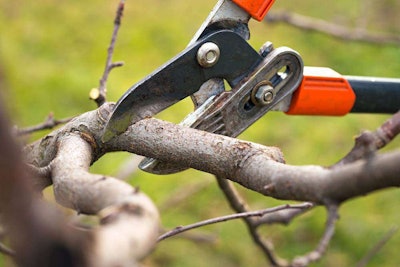
While winter is typically the most recommended season for heavy pruning, performing a bit of light pruning in the summer is equally beneficial, especially for fruit or damaged trees. Regardless of what’s being pruned, the benefits that come from this project can yield excellent results for your customer’s landscape.
Take a look at summer pruning techniques your crews can use to help the shape and structure of your customer’s trees.
Benefits
Pruning in the summer allows your crew to remove dead, diseased, or damaged limbs that might be a hazard to your customers, and it proves beneficial to the tree. When limbs such as these are present, it can cause stress or damage to the tree, which increases the tree’s potential for full growth while also minimizing the chance that these weakened branches will fall.
Pruning these trees in the summer can also encourage more vigorous growth. When pruning this season, weaker growth should be pruned back or pinched about 3 inches from the end of each shoot. If the growth of side shoots rapidly occurs, the process can be repeated later in the season.
For customers with fruit trees, a good pruning in the summer allows more light penetration, increased air circulation, and more hardy and durable branch development. Proper pruning of these trees can also potentially encourage mature trees to produce fruit that’s of better size and quality.
According to Urban Forest Pro, fruit trees like cherries, apricots, and more are susceptible to disease when they are pruned during the rainy season. For trees like these, it’s preferable to prune in July and August.
For trees like the Japanese plum, peach, and nectarine that grow quickly, summer pruning can encourage the development and growth of stronger branches.
Summer pruning can also serve as a mid-year pest control project. When removing branches and fruit that may be damaged by insects, the overall health and longevity of the tree are protected. This also helps ensure that your customer’s crop of fruit is free of bugs.
When disposing of these defective branches and fruits, be sure to dispose of them properly; to help prevent an infestation, avoid composting them.
Guidelines
If rain is in the immediate forecast, it’s best to hold off on pruning until drier conditions occur. Rain has a tendency to stir up elements of disease that could potentially make their way into fresh pruning cuts.
It’s also important to note, as previously mentioned, that the heavy pruning should be saved for winter, as the fruit trees will be dormant and less prone to stress in the winter. Summer pruning is done, predominantly, to maintain the structure of the trees.
It’s also better to start earlier than later when pruning in the summer. Since this pruning will encourage growth, the tree could be at risk of being injured in the winter if pruned too close to the end of summer.
For mature trees in less-than-ideal circumstances, it’s recommended to only prune 10 to 15 percent of the photosynthetic portion of the tree at one time.
For trees growing vigorously in fairly ideal circumstances, it’s recommended to prune 20 percent, and for saplings and other small, vigorous trees, 25 percent is recommended. Making good, clean cuts are also necessary, as the plant will be able to seal off the wound quickly.
For trees in need of structural work, summer is a great time to trim back and rearrange wayward branches. Water-sprouts, suckers, and crossing branches can be easily removed during this time.
If your crews use string or spacers, younger, more vigorous branches can be trained to create more balance in the structure of the branches, fill in canopy voids, and encourage stronger, wider crotches, which will be more resistant to splitting.
Keep in mind not to allow too much sun exposure to the trunk and to scaffold branches, which can scald the tree and open the wood to decay. To avoid this, be sure to leave enough canopy to shape the bark or your crews can treat the bark with whitewash.










